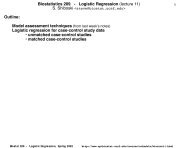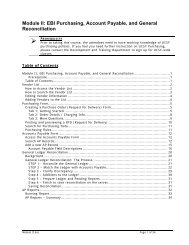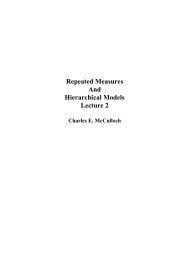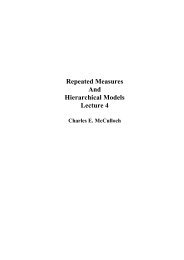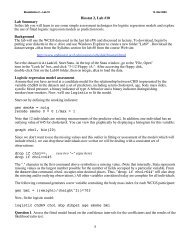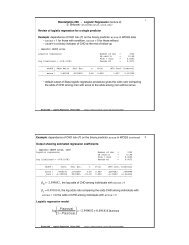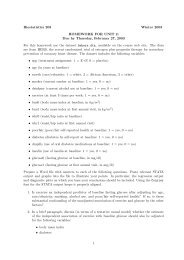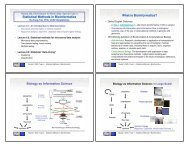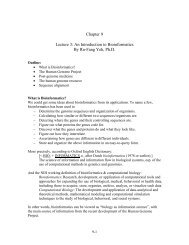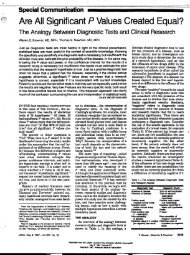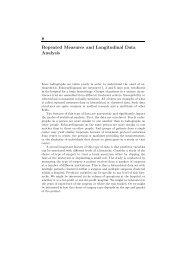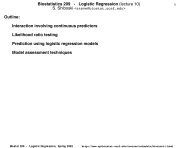A direct comparison of tirofiban and abciximab during percutaneous ...
A direct comparison of tirofiban and abciximab during percutaneous ...
A direct comparison of tirofiban and abciximab during percutaneous ...
You also want an ePaper? Increase the reach of your titles
YUMPU automatically turns print PDFs into web optimized ePapers that Google loves.
Trial Design<br />
A <strong>direct</strong> <strong>comparison</strong> <strong>of</strong> tir<strong>of</strong>iban <strong>and</strong> <strong>abciximab</strong><br />
<strong>during</strong> <strong>percutaneous</strong> coronary revascularization<br />
<strong>and</strong> stent placement: Rationale <strong>and</strong> design <strong>of</strong> the<br />
TARGET study<br />
David J. Moliterno, MD, <strong>and</strong> Eric J. Topol, MD, for the TARGET International Steering Committee* Clevel<strong>and</strong>, Ohio<br />
Background Trials testing intravenous platelet glycoprotein IIb/IIIa antagonists in the setting <strong>of</strong> <strong>percutaneous</strong> coronary<br />
revascularization <strong>and</strong> empirically <strong>during</strong> acute coronary syndromes have consistently demonstrated a reduction in<br />
ischemic events. These trials, however, have varied regarding patient population, type, duration <strong>and</strong> timing <strong>of</strong> IIb/IIIa therapy,<br />
adjunct therapies, <strong>and</strong> methods for collection <strong>and</strong> adjudication <strong>of</strong> end points. All trials were placebo-controlled, <strong>and</strong><br />
none involved a <strong>direct</strong> <strong>comparison</strong> <strong>of</strong> IIb/IIIa inhibitors. Whether these agents produce a similar clinical outcome in the contemporary<br />
practice <strong>of</strong> coronary interventions is uncertain.<br />
Methods <strong>and</strong> Results To evaluate the efficacy <strong>of</strong> tir<strong>of</strong>iban in patients undergoing <strong>percutaneous</strong> revascularization<br />
with stent placement, a r<strong>and</strong>omized, multicenter, double-blind, double-dummy, <strong>abciximab</strong>-controlled study is currently underway.<br />
All patients will receive preprocedural clopidogrel, weight-adjusted heparin, <strong>and</strong> aspirin. In 18 countries, 4750<br />
patients undergoing nonemergency <strong>percutaneous</strong> coronary revascularization will be studied. The primary end point will be<br />
the composite 30-day occurrence <strong>of</strong> death, myocardial infarction, or urgent target vessel revascularization. Secondary end<br />
points will include 6-month death, myocardial infarction, or any myocardial revascularization <strong>and</strong> 1-year death.<br />
Conclusion This is the first large-scale, head-to-head <strong>comparison</strong> <strong>of</strong> 2 established IIb/IIIa inhibitors in interventional cardiology.<br />
Enrollment is expected to be complete by mid-2000. (Am Heart J 2000;140:722-6.)<br />
Threatened <strong>and</strong> abrupt vessel closure <strong>during</strong> or shortly<br />
after <strong>percutaneous</strong> coronary intervention (PCI) is known<br />
to be caused by platelet-rich thrombus <strong>and</strong> vessel wall<br />
disruption. 1,2 Intracoronary stent placement mechanically<br />
lowers the incidence <strong>of</strong> abrupt vessel closure <strong>and</strong><br />
restenosis but can cause side-branch vessel closure <strong>and</strong><br />
atherothrombotic embolization. 3-5 These sequelae are<br />
also associated with an increase in platelet activation,<br />
periprocedural creatine kinase release, <strong>and</strong> late death. 5-7<br />
Platelet glycoprotein IIb/IIIa inhibitors pharmacologically<br />
block platelet aggregation <strong>and</strong> reduce the incidence <strong>of</strong><br />
ischemic events associated with acute coronary syndromes,<br />
<strong>percutaneous</strong> coronary revascularization, <strong>and</strong><br />
intracoronary stent placement. 5,8-14 Several agents (<strong>abciximab</strong><br />
[ReoPro], eptifibatide [Integrilin], <strong>and</strong> tir<strong>of</strong>iban<br />
[Aggrastat]) are now in widespread clinical use.<br />
The largest trial studying intracoronary stent implanta-<br />
From The Department <strong>of</strong> Cardiology <strong>and</strong> the Clevel<strong>and</strong> Clinic Cardiovascular Coordinating<br />
Center, The Clevel<strong>and</strong> Clinic Foundation, Clevel<strong>and</strong>, Ohio.<br />
*The Steering <strong>and</strong> Executive Committee members are listed in the Appendix.<br />
Submitted April 11, 2000; accepted July 12, 2000.<br />
Reprint requests: David J. Moliterno, MD, Department <strong>of</strong> Cardiology, F-25, The<br />
Clevel<strong>and</strong> Clinic Foundation, 9500 Euclid Ave, Clevel<strong>and</strong>, OH 44195.<br />
E-mail: molited@ccf.org<br />
Copyright © 2000 by Mosby, Inc.<br />
0002-8703/2000/$12.00 + 0 4/1/110094<br />
doi:10.1067/mhj.2000.110094<br />
tion r<strong>and</strong>omly assigned patients to <strong>abciximab</strong> or<br />
placebo. The Evaluation <strong>of</strong> Platelet IIb/IIIa Inhibitor for<br />
Stenting (EPISTENT) trial r<strong>and</strong>omly assigned 2399<br />
patients to intracoronary stent with placebo, balloon<br />
angioplasty with <strong>abciximab</strong>, or intracoronary stent with<br />
<strong>abciximab</strong>. 5 This study was able to compare short-term<br />
<strong>and</strong> long-term safety <strong>and</strong> efficacy outcomes <strong>of</strong> a<br />
mechanical strategy, a pharmacologic strategy, <strong>and</strong> the<br />
combination. The primary end point, 30-day composite<br />
<strong>of</strong> death, myocardial infarction (MI), <strong>and</strong> urgent target<br />
vessel revascularization, occurred in 10.8% <strong>of</strong> the<br />
stent/placebo group, 6.9% <strong>of</strong> the balloon/<strong>abciximab</strong><br />
group, <strong>and</strong> 5.3% <strong>of</strong> the stent/<strong>abciximab</strong> group. The<br />
reduction in ischemic events by the combination <strong>of</strong><br />
stent placement plus <strong>abciximab</strong> compared with stent<br />
alone was highly significant (hazard ratio 0.48 [95% confidence<br />
interval, 0.33-0.69], P < .001). The leading<br />
reduction in events was for death <strong>and</strong> large MI, <strong>and</strong> the<br />
treatment effect <strong>of</strong> <strong>abciximab</strong> persisted at 6-month follow-up.<br />
Likewise, the 1-year mortality rate was 57%<br />
lower for those assigned to stent/<strong>abciximab</strong> compared<br />
with stent alone (1.0% vs 2.4%; P = .037). 7 Recently, the<br />
Enhanced Suppression <strong>of</strong> Platelet Receptor GP IIb/IIIa<br />
Using Integrilin Therapy (ESPRIT) investigators reported<br />
results from the placebo-controlled trial testing eptifibatide,<br />
a small-molecule, short-acting IIb/IIIa antagonist,
American Heart Journal<br />
Volume 140, Number 5 Moliterno <strong>and</strong> Topol 723<br />
among patients undergoing elective stent placement.<br />
The preliminary 30-day results showed a 35% relative<br />
risk reduction in the composite end point <strong>of</strong> death, MI,<br />
<strong>and</strong> urgent revascularization with eptifibatide (10.4% vs<br />
6.8%). 15<br />
Tir<strong>of</strong>iban, also a small-molecule IIb/IIIa inhibitor, has<br />
been studied in both PCI 12 <strong>and</strong> in acute coronary syndromes.<br />
13,14 The R<strong>and</strong>omized Efficacy Study <strong>of</strong> Tir<strong>of</strong>iban<br />
for Outcomes <strong>and</strong> Restenosis (RESTORE) trial r<strong>and</strong>omly<br />
assigned 2141 patients to placebo or a bolus <strong>and</strong> 36-hour<br />
infusion <strong>of</strong> tir<strong>of</strong>iban. The 30-day occurrence <strong>of</strong> death, MI,<br />
or any target vessel revascularization for ischemia was<br />
nonsignificantly reduced by 16% with tir<strong>of</strong>iban compared<br />
with placebo (10.3% vs 12.2%; P = .169). Death or<br />
MI was reduced 19%, <strong>and</strong> using the same 30-day composite<br />
end point as the <strong>abciximab</strong> trials (ie, including only<br />
target vessel revascularization procedures which were<br />
urgent), end point events were reduced 24% by tir<strong>of</strong>iban<br />
(8.0% vs. 10.5%, P = .052). The Platelet Receptor Inhibition<br />
for Ischemic Syndrome Management in Patients Limited<br />
by Unstable Signs <strong>and</strong> Symptoms (PRISM-PLUS) trial<br />
studied patients with an acute coronary syndrome. Of<br />
the 1915 patients in the trial, 475 underwent PCI after<br />
receiving 48 hours <strong>of</strong> heparin <strong>and</strong> aspirin (control group)<br />
versus tir<strong>of</strong>iban, heparin, <strong>and</strong> aspirin. In this PCI subgroup,<br />
the probability <strong>of</strong> death or MI at 30 days was<br />
reduced by 44% with tir<strong>of</strong>iban (relative risk = 0.56; 95%<br />
confidence interval, 0.29-1.09).<br />
Because the large-scale clinical trials testing tir<strong>of</strong>iban<br />
were completed before the widespread use <strong>of</strong> intracoronary<br />
stents, there are limited data regarding their<br />
combination. With this in mind, we undertook the current<br />
study. The purpose <strong>of</strong> this study, the Do Tir<strong>of</strong>iban<br />
<strong>and</strong> ReoPro Give Similar Efficacy Outcomes Trial (TAR-<br />
GET), is to assess the efficacy <strong>of</strong> tir<strong>of</strong>iban in patients<br />
undergoing planned PCI with an intracoronary stent<br />
<strong>and</strong> to compare the efficacy <strong>of</strong> tir<strong>of</strong>iban versus <strong>abciximab</strong><br />
in this population.<br />
Patient population <strong>and</strong> entry criteria<br />
Patients from 18 countries scheduled to undergo nonemergency<br />
PCI with stent placement to a native coronary<br />
artery or arterial or venous coronary bypass graft<br />
are eligible for study entry. The <strong>percutaneous</strong> revascularization<br />
strategy may include any approved (noninvestigational)<br />
angioplasty catheter, atherectomy device, or<br />
stent. If multivessel PCI is being performed, stent placement<br />
should be planned for all sites. Study exclusion<br />
criteria include <strong>direct</strong> or rescue PCI for acute MI or<br />
planned staged procedure. Patients are excluded if they<br />
have received low-molecular-weight heparin, tir<strong>of</strong>iban,<br />
or eptifibatide within 10 hours or fibrinolytic therapy<br />
within 24 hours; undergone PCI or received <strong>abciximab</strong><br />
within 14 days; had prolonged cardiopulmonary resuscitation<br />
within 2 weeks; major surgery (including noncutaneous<br />
biopsy, any ophthalmologic or coronary<br />
bypass surgery) or an investigation drug or device<br />
within 1 month; severe physical trauma within 6<br />
weeks; gastrointestinal or genitourinary bleeding within<br />
3 months; transient neurologic ischemic attack within 6<br />
months; or nonhemorrhagic stroke within 2 years.<br />
Patients are also excluded for allergy, intolerance, or<br />
contraindication to any study medication. Other exclusions<br />
are pregnancy, pericarditis, significant retinopathy,<br />
persistent systolic blood pressure 180 mm<br />
Hg or diastolic blood pressure >105 mm Hg, coagulopathy<br />
or clinically important abnormal laboratory findings<br />
(including protime international normalized ratio >1.5,<br />
platelet count
724 Moliterno <strong>and</strong> Topol<br />
American Heart Journal<br />
November 2000<br />
Figure 1<br />
TARGET study schematic.<br />
venously within 24 hours <strong>of</strong> the procedure <strong>and</strong> 75 to<br />
325 mg daily throughout the study follow-up. An oral<br />
loading dose <strong>of</strong> clopidogrel will be administered within<br />
2 to 6 hours before the procedure when possible. If the<br />
coronary anatomy is unknown (ie, ad hoc PCI after<br />
diagnostic angiography), clopidogrel may be given as<br />
late as immediately before the procedure. For patients<br />
having taken 75 mg <strong>of</strong> clopidogrel daily (or ticlopidine<br />
250 mg twice daily) for ≥3 days or who have otherwise<br />
received ≥300 mg within the previous 48 hours, only<br />
75 mg clopidogrel will be given before the procedure.<br />
All patients (even those in whom a stent cannot be<br />
placed) will receive 75 mg clopidogrel daily for 30 days<br />
after the procedure.<br />
Guidelines for intravenous unfractionated heparin<br />
administration will be given, but dosing may be modified<br />
based on investigators’ clinical assessment. A targeted<br />
activated clotting time (ACT) <strong>of</strong> 250 seconds is<br />
recommended. For patients not receiving heparin<br />
within 4 hours <strong>of</strong> the procedure, a 70-U/kg bolus will<br />
be given. For patients receiving heparin within 4 hours<br />
<strong>and</strong> a preprocedural ACT
American Heart Journal<br />
Volume 140, Number 5 Moliterno <strong>and</strong> Topol 725<br />
mine the overall rate <strong>of</strong> patients reaching an end point.<br />
Since this rate was below 5.3%, the sample size was<br />
increased to 4750.<br />
Discussion<br />
Several features <strong>of</strong> this study are worth highlighting.<br />
To begin, this will be the first trial <strong>direct</strong>ly comparing 2<br />
IIb/IIIa antagonists. Previous placebo-controlled PCI trials<br />
testing the various agents have substantially differed,<br />
<strong>and</strong> these dissimilarities confound even in<strong>direct</strong> <strong>comparison</strong>s<br />
<strong>of</strong> agents. Considering the cost differences<br />
among agents, a head-to-head trial has both scientific<br />
<strong>and</strong> financial importance. Second, this will be the<br />
largest prospective study involving coronary stents.<br />
Other than EPISTENT (1603 patients with stents), most<br />
prospective stent studies have been for new device<br />
approval, <strong>and</strong> they have been relatively small. Third,<br />
unlike EPISTENT, which primarily included the first<br />
generation Johnson & Johnson coronary stent, this trial<br />
will involve second <strong>and</strong> third generation coronary<br />
stents. Fourth, the TARGET trial will be the first largescale<br />
IIb/IIIa trial to allow any approved revascularization<br />
device (eg, rotational, laser, <strong>and</strong> extraction atherectomy).<br />
Finally, the trial will allow <strong>and</strong> incorporate<br />
practical aspects <strong>of</strong> real-world interventional procedures,<br />
including preprocedural clopidogrel as well as<br />
ad hoc interventions with procedural clopidogrel loading,<br />
vascular closure devices, <strong>and</strong> ambulation <strong>during</strong><br />
study drug infusion.<br />
Because TARGET is comparing 2 approved <strong>and</strong> established<br />
drugs (ie, an active comparator trial), the statistical<br />
design <strong>and</strong> sample size are based on a noninferiority<br />
hypothesis. As such, tir<strong>of</strong>iban tested as an adjunct to<br />
intracoronary stenting is hypothesized to prevent<br />
ischemic events within the range <strong>of</strong> effect observed<br />
with <strong>abciximab</strong>. In clinical trials several factors affect<br />
sample size, including the expected end point event<br />
rate in the study group <strong>and</strong> the statistical design. For<br />
example, phase III cardiovascular pharmacologic trials<br />
testing new agents are <strong>of</strong>ten placebo-controlled, have a<br />
low primary end point event rate, are large in scale, <strong>and</strong><br />
are based on a superiority hypothesis. Other trials, testing<br />
a modification <strong>of</strong> a pharmacologic agent, may be<br />
statistically based on equivalency, such as the testing <strong>of</strong><br />
recombinant tissue plasminogen activator versus TNKtissue<br />
plasminogen activator (tenecteplase) <strong>and</strong> are<br />
moderately large in size. These <strong>and</strong> other factors are<br />
importantly influencing clinical trials in the new millennium.<br />
17<br />
Considering interagent differences, <strong>abciximab</strong> <strong>and</strong><br />
tir<strong>of</strong>iban are respectively distinguishable by structural<br />
characteristics (antibody vs peptidomimetic), molar<br />
concentration per IIb/IIIa receptor (2 vs >250), receptor<br />
specificity (α IIb β 3 , α v β 3 , <strong>and</strong> MAC-1 vs α IIb β 3 –specific),<br />
<strong>and</strong> duration <strong>of</strong> antiplatelet effect (days vs<br />
hours). The doses <strong>of</strong> <strong>abciximab</strong> <strong>and</strong> tir<strong>of</strong>iban administered<br />
in this study have been shown to inhibit ADPinduced<br />
platelet aggregation potently to a similar<br />
degree (>80% to 90%) <strong>and</strong> in a similar proportion <strong>of</strong><br />
patients. 18,19 Abciximab has been shown to lower the<br />
occurrence <strong>of</strong> ischemic events at 30 days in PCI trials<br />
by approximately 35% to 50% 5,10,11 compared with an<br />
approximate 20% lowering observed in most small-molecule<br />
PCI studies. 12,20 Most recently, the preliminary<br />
30-day results from the ESPRIT trial show a 35% reduction<br />
in the composite end point <strong>of</strong> death, MI, <strong>and</strong><br />
urgent revascularization with eptifibatide, 15 but again<br />
leave uncertainty whether this is comparable to the<br />
55% reduction in the same end point as seen with<br />
<strong>abciximab</strong> in EPISTENT. 5 Also, the early benefits <strong>of</strong><br />
<strong>abciximab</strong> have been shown to be durable at 6 months,<br />
<strong>and</strong> more recently a 1-year mortality rate benefit has<br />
been observed for patients receiving a coronary stent<br />
with <strong>abciximab</strong>. Regardless, it remains unclear if these<br />
results reflect potential differences among agents, trial<br />
designs, or both.<br />
The TARGET trial should provide valuable insight into<br />
the clinical importance <strong>of</strong> potent α IIb β 3 antagonism by<br />
different inhibitory mechanisms. It will also provide<br />
additional information on the durability <strong>of</strong> clinical benefit<br />
<strong>and</strong> impact on late death. Beyond this needed information,<br />
a key insight will be available for the outcome<br />
<strong>of</strong> patients treated with a contemporary, real-world<br />
approach. The trial is expected to complete its enrollment<br />
in mid-2000.<br />
References<br />
1. Linc<strong>of</strong>f AM, Topol EJ. Abrupt vessel closure. In: Topol EJ, editor.<br />
Textbook <strong>of</strong> interventional cardiology. 2nd ed. Philadelphia: WB<br />
Saunders; 1993. p. 212.<br />
2. Gawaz M, Neumann FJ, Ott I, et al. Changes in membrane glycoproteins<br />
<strong>of</strong> circulating platelets after coronary stent implantation.<br />
Heart 1996;76:166-72.<br />
3. Serruys PW, de Jaegere P, Kiemeneij F, et al. A <strong>comparison</strong> <strong>of</strong> balloon<br />
exp<strong>and</strong>able-stent implantation with balloon angioplasty in<br />
patients with coronary artery disease. N Engl J Med<br />
1994;331:489-95.<br />
4. Fischman DL, Leon MB, Baim DS, et al. A r<strong>and</strong>omized <strong>comparison</strong> <strong>of</strong><br />
coronary stent placement <strong>and</strong> balloon angioplasty in the treatment<br />
<strong>of</strong> coronary artery disease. N Engl J Med 1994;331:496-501.<br />
5. The EPISTENT investigators. R<strong>and</strong>omised placebo-controlled <strong>and</strong><br />
balloon-angioplasty-controlled trial to assess safety <strong>of</strong> coronary<br />
stenting with use <strong>of</strong> platelet glycoprotein-IIb/IIIa blockade. Lancet<br />
1998;352:87-92.<br />
6. Grines CL, Cox DA, Stone GW, et al. Coronary angioplasty with or<br />
without stent implantation for acute myocardial infarction. Stent Primary<br />
Angioplasty in Myocardial Infarction Study Group. N Engl J<br />
Med 1999;341:1949-56.<br />
7. Topol EJ, Mark DB, Linc<strong>of</strong>f AM, et al. Outcomes at 1 year <strong>and</strong> economic<br />
implications <strong>of</strong> platelet glycoprotein IIb/IIIa blockade in<br />
patients undergoing coronary stenting: results from a multicentre<br />
r<strong>and</strong>omised trial. Evaluation <strong>of</strong> Platelet IIb/IIIa Inhibitor for Stenting.<br />
Lancet 1999;354:2019-24.<br />
8. The PURSUIT trial investigators. Inhibition <strong>of</strong> platelet glycoprotein
726 Moliterno <strong>and</strong> Topol<br />
American Heart Journal<br />
November 2000<br />
IIb/IIIa with eptifibatide in patients with acute coronary syndromes.<br />
N Engl J Med 1998;339:436-63.<br />
9. The CAPTURE investigators. R<strong>and</strong>omised placebo-controlled trial<br />
<strong>of</strong> <strong>abciximab</strong> before <strong>and</strong> <strong>during</strong> coronary interventions in refractory<br />
unstable angina: the CAPTURE study. Lancet<br />
1997;349:1429-35.<br />
10. The EPIC investigators. Use <strong>of</strong> a monoclonal antibody <strong>direct</strong>ed<br />
against the platelet glycoprotein IIb/IIIa receptor in high-risk coronary<br />
angioplasty. N Engl J Med 1994;330:956-61.<br />
11. The EPILOG investigators. Platelet glycoprotein IIb/IIIa receptor<br />
blockade <strong>and</strong> low-dose heparin <strong>during</strong> <strong>percutaneous</strong> coronary<br />
revascularization. N Engl J Med 1997:1689-96.<br />
12. The RESTORE investigators. Effects <strong>of</strong> platelet glycoprotein IIb/IIIa<br />
blockade with tir<strong>of</strong>iban on adverse cardiac events in patients with<br />
unstable angina or acute myocardial infarction undergoing coronary<br />
angioplasty. Circulation 1997;96:1445-53.<br />
13. The Platelet Receptor Inhibition in Ischemic Syndrome Management<br />
(PRISM) study investigators. A <strong>comparison</strong> <strong>of</strong> aspirin plus tir<strong>of</strong>iban<br />
with aspirin plus heparin for unstable angina. N Engl J Med<br />
1998;338:1498-505.<br />
14. The Platelet Receptor Inhibition in Ischemic Syndrome Management<br />
in Patients Limited by Unstable Signs <strong>and</strong> Symptoms (PRISM-PLUS)<br />
study investigators. Inhibition <strong>of</strong> the platelet glycoprotein IIb/IIIa<br />
receptor with tir<strong>of</strong>iban in unstable angina <strong>and</strong> non-Q-wave myocardial<br />
infarction. N Engl J Med 1998;338:1488-97.<br />
15. Tcheng J for the ESPRIT investigators. Preliminary results from the<br />
ESPRIT study. Presented at the Annual Meeting <strong>of</strong> the Society for Cardiac<br />
Angiography <strong>and</strong> Intervention. Charleston, SC, May 2000.<br />
16. Kereiakes D, Kleiman N, Ambrose J, et al. R<strong>and</strong>omized, doubleblind,<br />
placebo-controlled dose-ranging study <strong>of</strong> tir<strong>of</strong>iban (MK-383)<br />
platelet IIb/IIIa blockade in high risk patients undergoing coronary<br />
angioplasty. J Am Coll Cardiol 1996;27:536-42.<br />
17. Topol EJ, Califf RM, Van de Werf F, et al. Perspectives on largescale<br />
cardiovascular clinical trials for the new millennium. Circulation<br />
1997;95:1072-82.<br />
18. Kereiakes D, Broderick T, Roth E, et al. Time course, magnitude, <strong>and</strong><br />
consistency <strong>of</strong> platelet inhibition by <strong>abciximab</strong>, tir<strong>of</strong>iban, or eptifibatide<br />
in patients with unstable angina pectoris undergoing <strong>percutaneous</strong><br />
coronary intervention. Am J Cardiol 1999;84:391-5.<br />
19. Steinhubl S, Talley D, Kereiakes D, et al. A prospective multicenter<br />
study to assess the optimal level <strong>of</strong> platelet inhibition with GP<br />
IIb/IIIa inhibitors in patients undergoing coronary intervention: the<br />
GOLD study [abstract]. J Am Coll Cardiol 2000;35:44A.<br />
20. The IMPACT-II investigators. R<strong>and</strong>omized placebo-controlled trial <strong>of</strong><br />
effect <strong>of</strong> eptifibatide on complications <strong>of</strong> <strong>percutaneous</strong> coronary<br />
intervention: IMPACT-II. Lancet 1997;349:1422-8.<br />
Appendix<br />
International Steering <strong>and</strong> Executive Committees<br />
Topol EJ (chair), Ardissino D, Bass<strong>and</strong> J-P, Beauchamp<br />
GD, Bertr<strong>and</strong> M, Bunt T, Chronos NA, Cohen E, Cohen<br />
M, Demopoulos L, DiBattiste P, Hamm C, Herrmann<br />
HC, Kristensen SD, Lange RA, Miguel CM, Meier B,<br />
Moliterno DJ, Neumann FJ, Stone GW, Yakubov SJ,<br />
Yeung AC



